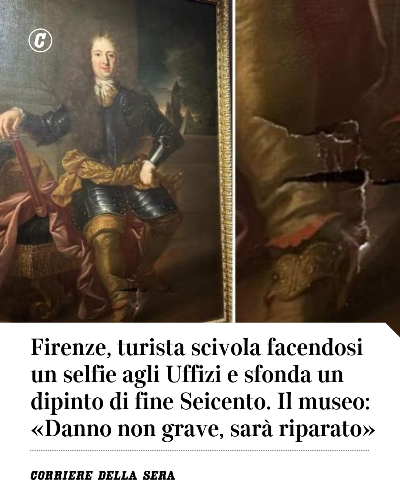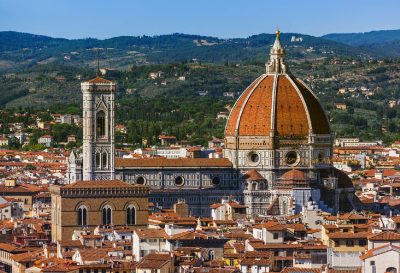
©
У розпал туристичного сезону в одній із найвідоміших художніх галерей світу стався прикрий інцидент, який знову підняв на поверхню питання культурної відповідальності гостей музеїв. Відвідувач галереї Уффіці, прагнучи зробити вдале селфі, спирався на бароковий портрет «Фердінандо де Медічі, великий принц Тоскани» (1690) роботи Антона Доменіко Габбьяні, допоки полотно не прогнулося й не отримало пошкодження. Камери відеоспостереження зафіксували момент інциденту, відео швидко поширилось у соціальних мережах і викликало бурхливу реакцію серед громадськості. На оприлюдненому фото від Corriere Fiorentino видно помітний розрив на рівні ноги зображеної фігури. За офіційним повідомленням керівництва галереї, ушкодження не є критичним і полотно вже передано на реставрацію. Симоне Верде, директор галереї, у коментарі для агенції ANSA висловив глибоке обурення: «Культура дедалі частіше стає лише фоном для контенту в соцмережах. Ми впровадимо жорсткіші правила поведінки, щоб захистити мистецтво від бездумного споживання». Інцидент набув широкого розголосу у ЗМІ та соцмережах, підживлюючи загальноєвропейську дискусію про нову етику музейного простору. Дискусія набирає обертів у соціальних мережах, користувачі активно обговорюють баланс між відкритістю музеїв і необхідністю посилення охоронного режиму. Лише тижнем раніше у Вероні двоє туристів під час селфі, зруйнували мистецьку інсталяцію «стілець Ван Гога» митця Нікола Болли, всіяний кристалами Swarovski.
. Selfies versus heritage: how social media is destroying art
At the height of the tourist season, a troubling incident at one of the world’s most renowned art galleries has reignited the debate over cultural responsibility in public spaces. A visitor to the Uffizi Gallery in Florence, attempting to take a selfie, leaned against the Baroque painting Ferdinando de Medici, Grand Prince of Tuscany (1690) by Anton Domenico Gabbiani. The canvas gave way, resulting in visible damage. Surveillance footage captured the moment, and the video quickly went viral on social media, triggering a wave of public backlash. A photo published by Corriere Fiorentino shows a noticeable tear near the lower section of the painting, around the subject's leg. According to museum officials, the damage is not critical and is repairable. The artwork has already been removed for restoration. Gallery director Simone Verde expressed his frustration in a statement to the ANSA news agency: Culture is increasingly being reduced to a backdrop for social media content. We are implementing stricter behavioural rules to protect heritage from careless consumption. The incident has sparked widespread discussion across Europe, fuelling debates about museum ethics in the digital era. Social media users are actively questioning how institutions can balance openness and accessibility with necessary security measures. Just a week earlier in Verona, another mishap occurred when two tourists inadvertently damaged the Van Gogh Chair, a Swarovski crystal-encrusted sculpture by artist Nicola Bolla, while posing for a selfie.

©
2450